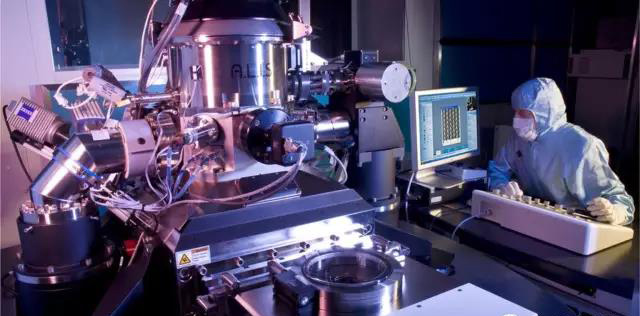
Image copyright: BRIAN BELL/SCIENCE PHOTO LIBRARY
Image caption: Helium is used in science in microscopes
Scientists have discovered a large helium gas field in Tanzania.
With world supplies running out, the find is a "game-changer", say geologists at Durham and Oxford universities.
Helium is used in hospitals in MRI scanners as well as in spacecraft, telescopes and radiation monitors.
Until now, the precious gas has been discovered only in small quantities during oil and gas drilling.
Using a new exploration approach, researchers found large quantities of helium within the Tanzanian East African Rift Valley.
They say resources in just one part of the Rift valley are enough to fill more than a million medical MRI scanners.
Prof Chris Ballentine, of the Department of Earth Sciences at the University of Oxford, said: "This is a game-changer for the future security of society's helium needs and similar finds in the future may not be far away."
And colleague Dr Pete Barry added: "We can apply this same strategy to other parts of the world with a similar geological history to find new helium resources. "
 Image copyright: THINKSTOCK
Image copyright: THINKSTOCKWhat helium is used for
It is used in the space industry to keep satellite instruments cool, to clean out rocket engines and was used to cool the liquid oxygen and hydrogen that powered the Apollo space vehicles
Helium is used as a cooling medium for the Large Hadron Collider (LHC) and the superconducting magnets in medical MRI scanners
Helium is often used to fill party balloons, weather balloons and airships because of its low density
A mixture of 80% helium and 20% oxygen is used by deep-sea divers and others working under pressurised conditions.
Helium-neon gas lasers are used to scan barcodes at supermarket checkouts
Helium is formed by the slow and steady radioactive decay of terrestrial rock. However, global supplies are running low, with warnings that supplies cannot be guaranteed in the long term.
Prof Jon Gluyas, of the Department of Earth Sciences at Durham University, who collaborated on the project, said the price of helium had gone up 500% in the last 15 years.
"Helium is the second most abundant element in the Universe but it's exceedingly rare on Earth," Prof Gluyas told BBC News.
"Moreover, any helium that you do find if you're not careful, will escape, just like a party balloon it rises and rises in the atmosphere and eventually escapes the Earth's gravity altogether.
"It's used in a whole array of key instrumentation, particularly medical MRI scanning and so on, and so we have to keep finding more."
Volcanic clues
The researchers say volcanic activity in the Rift Valley releases helium buried in ancient rocks, which rises up and becomes trapped in shallower gas fields.
The amount of helium is estimated at more than 54 billion cubic feet - which could potentially meet global demand for several years.
The next step is to find the best place to drill to exploit the gas and bring it to the surface.


